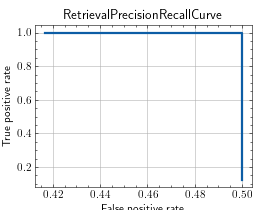Retrieval Precision Recall Curve¶
Module Interface¶
- class torchmetrics.retrieval.RetrievalPrecisionRecallCurve(max_k=None, adaptive_k=False, empty_target_action='neg', ignore_index=None, aggregation='mean', **kwargs)[source]¶
Compute precision-recall pairs for different k (from 1 to max_k).
In a ranked retrieval context, appropriate sets of retrieved documents are naturally given by the top k retrieved documents. Recall is the fraction of relevant documents retrieved among all the relevant documents. Precision is the fraction of relevant documents among all the retrieved documents. For each such set, precision and recall values can be plotted to give a recall-precision curve.
As input to
forwardandupdatethe metric accepts the following input:preds(Tensor): A float tensor of shape(N, ...)target(Tensor): A long or bool tensor of shape(N, ...)indexes(Tensor): A long tensor of shape(N, ...)which indicate to which query a prediction belongs
As output to
forwardandcomputethe metric returns the following output:precisions(Tensor): A tensor with the fraction of relevant documents among all the retrieved documents.recalls(Tensor): A tensor with the fraction of relevant documents retrieved among all the relevant documentstop_k(Tensor): A tensor with k from 1 to max_k
All
indexes,predsandtargetmust have the same dimension and will be flatten at the beginning, so that for example, a tensor of shape(N, M)is treated as(N * M, ). Predictions will be first grouped byindexesand then will be computed as the mean of the metric over each query.- Parameters:
max_k¶ (
Optional[int]) – Calculate recall and precision for all possible top k from 1 to max_k (default: None, which considers all possible top k)adaptive_k¶ (
bool) – adjust k to min(k, number of documents) for each querySpecify what to do with queries that do not have at least a positive
target. Choose from:'neg': those queries count as0.0(default)'pos': those queries count as1.0'skip': skip those queries; if all queries are skipped,0.0is returned'error': raise aValueError
ignore_index¶ (
Optional[int]) – Ignore predictions where the target is equal to this number.aggregation¶ (
Union[Literal['mean','median','min','max'],Callable]) –Specify how to aggregate over indexes. Can either a custom callable function that takes in a single tensor and returns a scalar value or one of the following strings:
'mean': average value is returned'median': median value is returned'max': max value is returned'min': min value is returned
kwargs¶ (
Any) – Additional keyword arguments, see Advanced metric settings for more info.
- Raises:
ValueError – If
empty_target_actionis not one oferror,skip,negorpos.ValueError – If
ignore_indexis not None or an integer.ValueError – If
max_kparameter is not None or not an integer larger than 0.
Example
>>> from torch import tensor >>> from torchmetrics.retrieval import RetrievalPrecisionRecallCurve >>> indexes = tensor([0, 0, 0, 0, 1, 1, 1]) >>> preds = tensor([0.4, 0.01, 0.5, 0.6, 0.2, 0.3, 0.5]) >>> target = tensor([True, False, False, True, True, False, True]) >>> r = RetrievalPrecisionRecallCurve(max_k=4) >>> precisions, recalls, top_k = r(preds, target, indexes=indexes) >>> precisions tensor([1.0000, 0.5000, 0.6667, 0.5000]) >>> recalls tensor([0.5000, 0.5000, 1.0000, 1.0000]) >>> top_k tensor([1, 2, 3, 4])
- plot(curve=None, ax=None)[source]¶
Plot a single or multiple values from the metric.
- Parameters:
- Return type:
- Returns:
Figure and Axes object
- Raises:
ModuleNotFoundError – If matplotlib is not installed
>>> import torch >>> from torchmetrics.retrieval import RetrievalPrecisionRecallCurve >>> # Example plotting a single value >>> metric = RetrievalPrecisionRecallCurve() >>> metric.update(torch.rand(10,), torch.randint(2, (10,)), indexes=torch.randint(2,(10,))) >>> fig_, ax_ = metric.plot()

Functional Interface¶
- torchmetrics.functional.retrieval.retrieval_precision_recall_curve(preds, target, max_k=None, adaptive_k=False)[source]¶
Compute precision-recall pairs for different k (from 1 to max_k).
In a ranked retrieval context, appropriate sets of retrieved documents are naturally given by the top k retrieved documents.
Recall is the fraction of relevant documents retrieved among all the relevant documents. Precision is the fraction of relevant documents among all the retrieved documents.
For each such set, precision and recall values can be plotted to give a recall-precision curve.
predsandtargetshould be of the same shape and live on the same device. If notargetisTrue,0is returned.targetmust be either bool or integers andpredsmust befloat, otherwise an error is raised.- Parameters:
preds¶ (
Tensor) – estimated probabilities of each document to be relevant.target¶ (
Tensor) – ground truth about each document being relevant or not.max_k¶ (
Optional[int]) – Calculate recall and precision for all possible top k from 1 to max_k (default: None, which considers all possible top k)adaptive_k¶ (
bool) – adjust max_k to min(max_k, number of documents) for each query
- Return type:
- Returns:
Tensor with the precision values for each k (at
top_k) from 1 to max_k Tensor with the recall values for each k (attop_k) from 1 to max_k Tensor with all possibles k- Raises:
ValueError – If
max_kis not None or an integer larger than 0.ValueError – If
adaptive_kis not boolean.
Example
>>> from torch import tensor >>> from torchmetrics.functional import retrieval_precision_recall_curve >>> preds = tensor([0.2, 0.3, 0.5]) >>> target = tensor([True, False, True]) >>> precisions, recalls, top_k = retrieval_precision_recall_curve(preds, target, max_k=2) >>> precisions tensor([1.0000, 0.5000]) >>> recalls tensor([0.5000, 0.5000]) >>> top_k tensor([1, 2])
